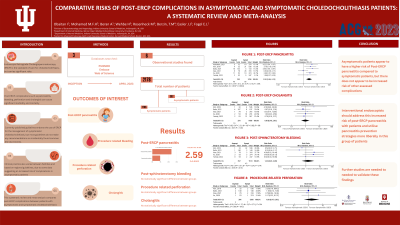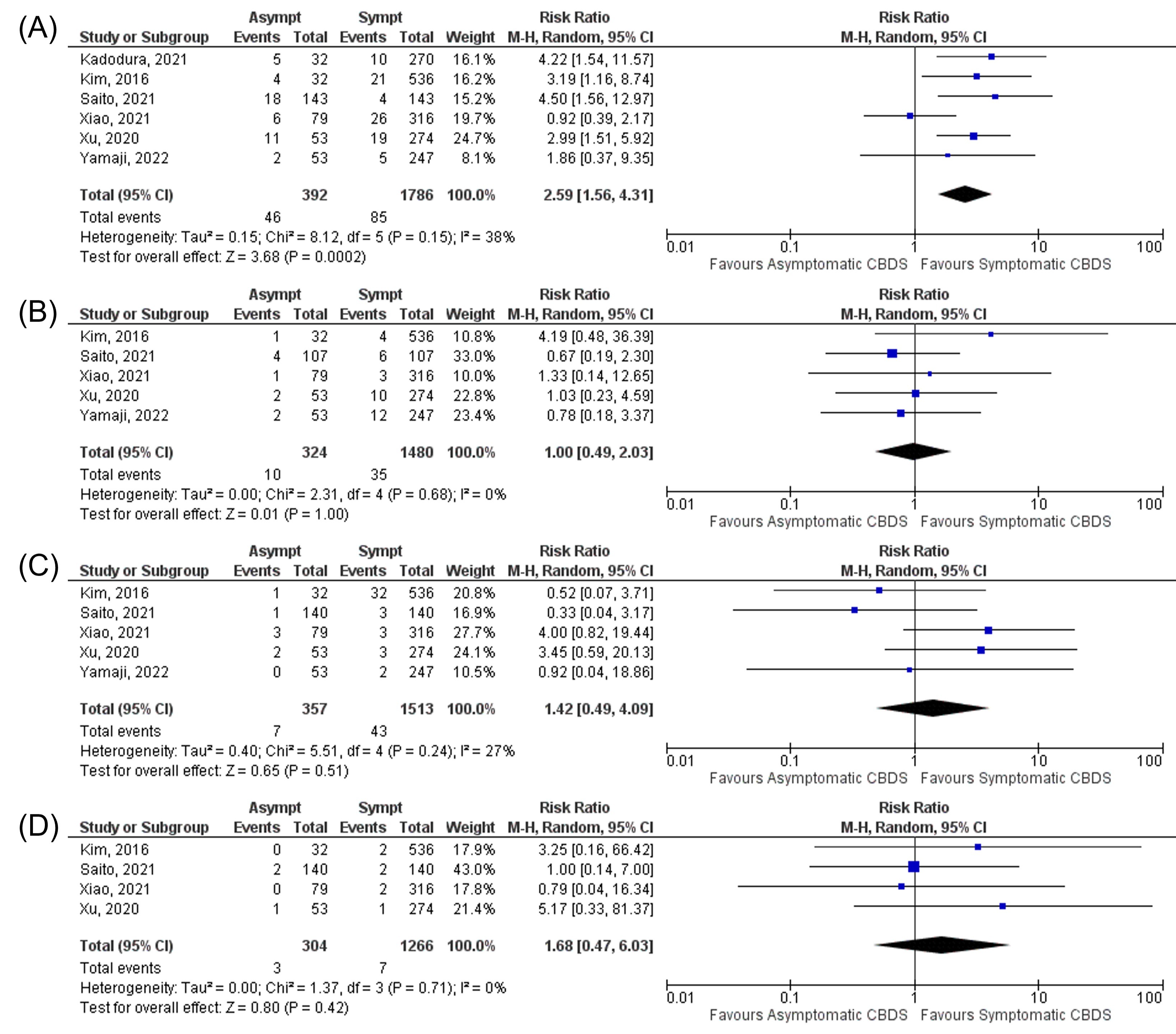Tuesday Poster Session
Category: Biliary/Pancreas
P2870 - Comparative Risks of Post-ERCP Pancreatitis in Asymptomatic and Symptomatic Choledocholithiasis Patients: A Systematic Review and Meta-Analysis
Tuesday, October 24, 2023
10:30 AM - 4:00 PM PT
Location: Exhibit Hall

Has Audio

Itegbemie Obaitan, MD, MPH
Indiana University School of Medicine
Indianapolis, IN
Presenting Author(s)
Itegbemie Obaitan, MD, MPH1, Mouhand FH. Mohamed, MD2, Azizullah Beran, MD3, Hisham Wehbe, MD1, Michael Rosenheck, MD1, Tyler Berzin, MD, FACG4, Jeffrey Easler, MD3, Evan Fogel, MD1
1Indiana University School of Medicine, Indianapolis, IN; 2Brown University, Providence, RI; 3Indiana University, Indianapolis, IN; 4Beth Israel Deaconess Medical Center, Boston, MA
Introduction: Endoscopic retrograde cholangiopancreatography (ERCP) is the standard of care for choledocholithiasis but carries significant risks such as post-ERCP pancreatitis (PEP) which can cause significant morbidity and mortality. While currently available guidelines endorse the use of ERCP for the management of symptomatic common bile duct stones (CBDS), the need for ERCP in incidentally found asymptomatic CBDS is more controversial and practice varies at an institutional level. This systematic review and meta-analysis compares post-ERCP complications between asymptomatic and symptomatic choledocholithiasis patients.
Methods: We conducted a comprehensive search of PubMed, Embase and Web of Science databases up to April 2023 to find studies comparing post-ERCP outcomes between asymptomatic and symptomatic choledocholithiasis patients. The primary outcome was PEP, while secondary outcomes included post-ERCP cholangitis, bleeding, and perforation. We calculated pooled risk ratios (RR) and 95% confidence intervals (CIs) using the Mantel-Haenszel method within a random-effect model.
Results: Our analysis incorporated six retrospective studies, totaling 2,178 CBDS patients (392 asymptomatic and 1,786 symptomatic). Asymptomatic CBDS patients exhibited a significantly higher risk of PEP (11.7% vs. 4.8%; RR 2.59, 95%CI 1.56-4.31, p=0.0002) (Figure 1-A). No significant difference was observed in post-ERCP cholangitis, bleeding, or perforation rates between the groups (Figure 1B-D respectively.
Discussion: Asymptomatic patients appear to have a higher risk of PEP compared to symptomatic patients, while the risk of other post-ERCP complications appear to be similar between both groups. Interventional endoscopists should thoroughly discuss potential complications (particularly PEP) with asymptomatic patients before performing ERCP, and consider utilizing PEP-prevention measures more liberally in this subgroup of patients. Further randomized controlled trials are needed to validate these findings and investigate the efficacy and safety of ERCP intervention versus watchful waiting in managing asymptomatic CBDS.

Disclosures:
Itegbemie Obaitan, MD, MPH1, Mouhand FH. Mohamed, MD2, Azizullah Beran, MD3, Hisham Wehbe, MD1, Michael Rosenheck, MD1, Tyler Berzin, MD, FACG4, Jeffrey Easler, MD3, Evan Fogel, MD1. P2870 - Comparative Risks of Post-ERCP Pancreatitis in Asymptomatic and Symptomatic Choledocholithiasis Patients: A Systematic Review and Meta-Analysis, ACG 2023 Annual Scientific Meeting Abstracts. Vancouver, BC, Canada: American College of Gastroenterology.
1Indiana University School of Medicine, Indianapolis, IN; 2Brown University, Providence, RI; 3Indiana University, Indianapolis, IN; 4Beth Israel Deaconess Medical Center, Boston, MA
Introduction: Endoscopic retrograde cholangiopancreatography (ERCP) is the standard of care for choledocholithiasis but carries significant risks such as post-ERCP pancreatitis (PEP) which can cause significant morbidity and mortality. While currently available guidelines endorse the use of ERCP for the management of symptomatic common bile duct stones (CBDS), the need for ERCP in incidentally found asymptomatic CBDS is more controversial and practice varies at an institutional level. This systematic review and meta-analysis compares post-ERCP complications between asymptomatic and symptomatic choledocholithiasis patients.
Methods: We conducted a comprehensive search of PubMed, Embase and Web of Science databases up to April 2023 to find studies comparing post-ERCP outcomes between asymptomatic and symptomatic choledocholithiasis patients. The primary outcome was PEP, while secondary outcomes included post-ERCP cholangitis, bleeding, and perforation. We calculated pooled risk ratios (RR) and 95% confidence intervals (CIs) using the Mantel-Haenszel method within a random-effect model.
Results: Our analysis incorporated six retrospective studies, totaling 2,178 CBDS patients (392 asymptomatic and 1,786 symptomatic). Asymptomatic CBDS patients exhibited a significantly higher risk of PEP (11.7% vs. 4.8%; RR 2.59, 95%CI 1.56-4.31, p=0.0002) (Figure 1-A). No significant difference was observed in post-ERCP cholangitis, bleeding, or perforation rates between the groups (Figure 1B-D respectively.
Discussion: Asymptomatic patients appear to have a higher risk of PEP compared to symptomatic patients, while the risk of other post-ERCP complications appear to be similar between both groups. Interventional endoscopists should thoroughly discuss potential complications (particularly PEP) with asymptomatic patients before performing ERCP, and consider utilizing PEP-prevention measures more liberally in this subgroup of patients. Further randomized controlled trials are needed to validate these findings and investigate the efficacy and safety of ERCP intervention versus watchful waiting in managing asymptomatic CBDS.

Figure: Forest plots for Post-ERCP complications (A - Post-ERCP pancreatitis, B - post-ERCP cholangitis, C - Post-procedure bleeding, D - Perforation) in asymptomatic and symptomatic choledocholithiasis patients.
Disclosures:
Itegbemie Obaitan indicated no relevant financial relationships.
Mouhand Mohamed indicated no relevant financial relationships.
Azizullah Beran indicated no relevant financial relationships.
Hisham Wehbe indicated no relevant financial relationships.
Michael Rosenheck indicated no relevant financial relationships.
Tyler Berzin: Boston Scientific – Consultant. Fuji – Consultant. Medtronic – Consultant.
Jeffrey Easler: Boston Scientific – Consultant.
Evan Fogel indicated no relevant financial relationships.
Itegbemie Obaitan, MD, MPH1, Mouhand FH. Mohamed, MD2, Azizullah Beran, MD3, Hisham Wehbe, MD1, Michael Rosenheck, MD1, Tyler Berzin, MD, FACG4, Jeffrey Easler, MD3, Evan Fogel, MD1. P2870 - Comparative Risks of Post-ERCP Pancreatitis in Asymptomatic and Symptomatic Choledocholithiasis Patients: A Systematic Review and Meta-Analysis, ACG 2023 Annual Scientific Meeting Abstracts. Vancouver, BC, Canada: American College of Gastroenterology.
